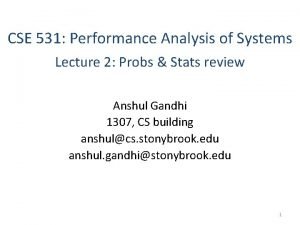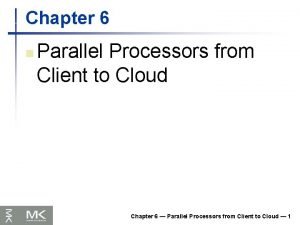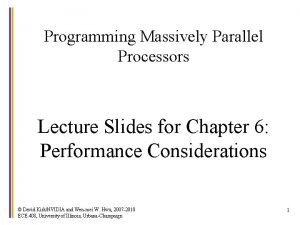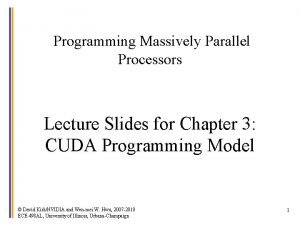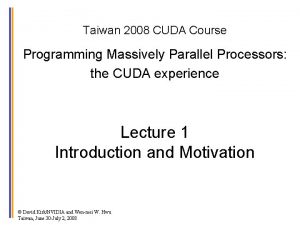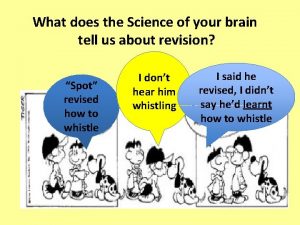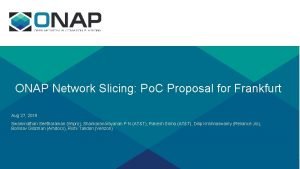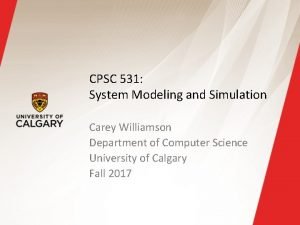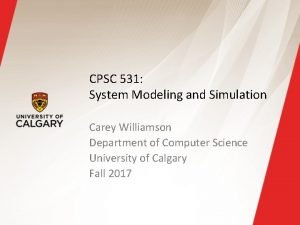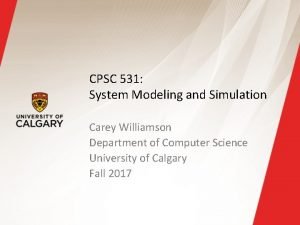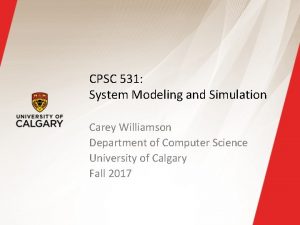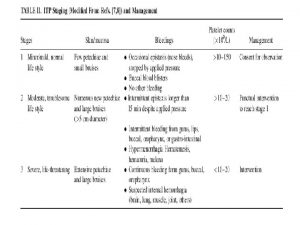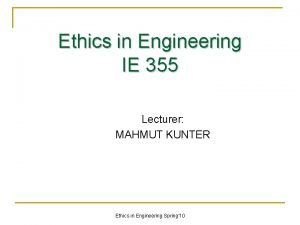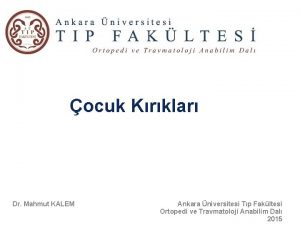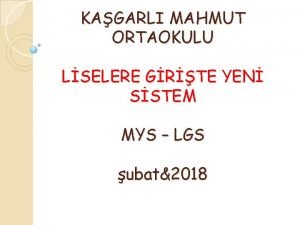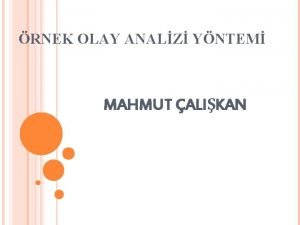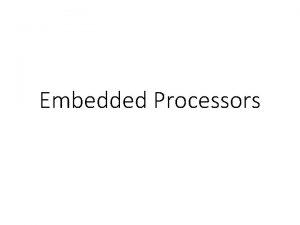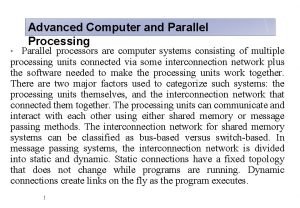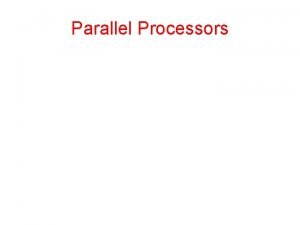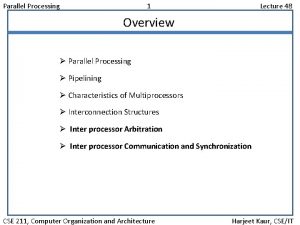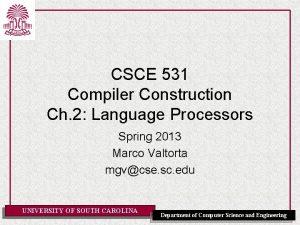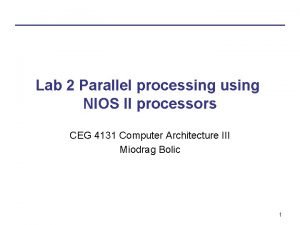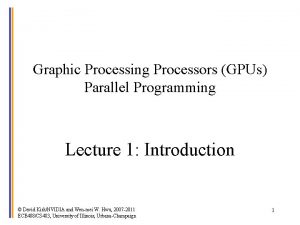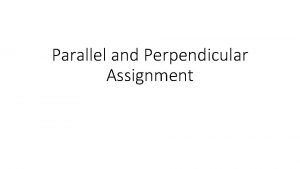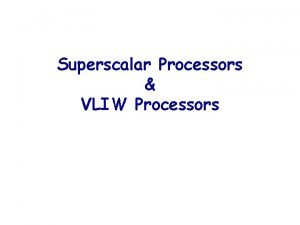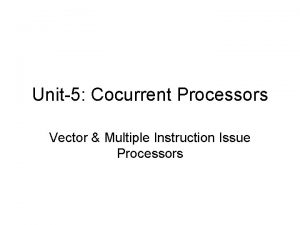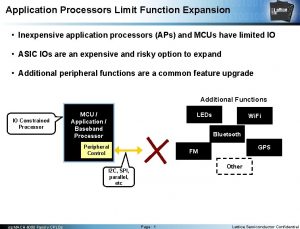CSE 531 Parallel Processors and Processing Dr Mahmut











![The Computational Power Argument Moore's law states [1965]: ``The complexity for minimum component costs The Computational Power Argument Moore's law states [1965]: ``The complexity for minimum component costs](https://slidetodoc.com/presentation_image_h/05ac97c1e38077f7944d104f957a33fb/image-12.jpg)










- Slides: 22

CSE 531 Parallel Processors and Processing Dr. Mahmut Kandemir

Topic Overview Course Administration n Motivating Parallelism n Scope of Parallel Computing Applications n Organization and Contents of the Course n

CSE 531, Fall 2005 n This is CSE 531— “Parallel Processors and Processing” Topics in the understanding, designing, and implementing of parallel systems and algorithms. We will study essential concepts and structures found in modern parallel computing, and compare different paradigms. Important facts – Instructor: Mahmut Kandemir (kandemir@cse. psu. edu) – Office: IST 354 C; Office Hours: T-Th 10 AM to 11 AM n Teaching Assistant – No such luck! n Basis for Grades (tentative) – Mid-term : 30% – Final : 40% – Homeworks and Programming Assignments: 30% n

Homeworks and Exams n Exams (closed notes, closed book) – Mid-term & comprehensive final n Homeworks – Several homework assignments – Cover mundane issues and provide drill – I will prepare and grade them n Programming Assignments – – – Certain homeworks will include programming assignments Thread, MPI, Open. MP programming Will cover several aspects of parallel computing & algorithms

Class-Taking Strategy for CSE 531 n I will use a “slide show” n You need to read the book and attend the class n I’m terrible with names – I need to moderate my speed (and it is really difficult) – You need to learn to say STOP and REPEAT – Close correspondence – Material in book that will not appear in lecture – You are responsible for material from class and assigned parts from book (reading assignments) – Coming to class regularly is an excellent strategy § I will record attendance! – Forgive me (in advance) forgetting – Help me out by reminding me of your names – Feel free to send e-mail to § Discuss/remind something § Arrange a meeting outside office hours

About the Book n Introduction to Parallel Computing – A. Grama, A. Gupta, G. Karypis, V. Kumar – Second Edition, Addison Wesley n Book presents modern material – Addresses current techniques/issues – Talks about both parallel architectures and algorithms n Other relevant textbooks will be on reserve in library

Homeworks n n No late assignment will be accepted Exceptions only under the most dire of circumstances Turn in what you have; I am generous with partial credit Solutions to most assignments will be made online or discussed in the class after the due date

Collaboration n Collaboration is encouraged – But, you have to work through everything yourself – share ideas, but not code or write-ups – I have no qualms about giving everybody (who survives) a high grade if they deserve it, so you don’t have to compete – In fact, if you co-operate, you will learn more n Any apparent cases of collaboration on exams, or of unreported collaboration on assignments will be treated as academic dishonesty

About the Instructor n My own research – Compiling for advanced microprocessor systems with deep memory hierarchies – Optimization for embedded systems (space, power, speed, reliability) – Energy-conscious hardware and software design – Just-in-Time (JIT) compilation and dynamic code generation for Java – Large scale input/output systems n Thus, my interests lie in – Quality of generated code – Interplay between compile, architecture, and programming languages – Static and dynamic analysis to understand program behavior – Custom compilation techniques and data management n Visit: http: //www. cse. psu. edu/~kandemir/

Motivating Parallelism n The role of parallelism in accelerating computing speeds has been recognized for several decades. n Its role in providing multiplicity of datapaths and increased access to storage elements has been significant in commercial applications. n The scalable performance and lower cost of parallel platforms is reflected in the wide variety of applications.

Motivating Parallelism n n n Developing parallel hardware and software has traditionally been time and effort intensive. If one is to view this in the context of rapidly improving uniprocessor speeds, one is tempted to question the need for parallel computing. There are some unmistakable trends in hardware design, which indicate that uniprocessor (or implicitly parallel) architectures may not be able to sustain the rate of realizable performance increments in the future. This is the result of a number of fundamental physical and computational limitations. The emergence of standardized parallel programming environments, libraries, and hardware have significantly reduced time to (parallel) solution.
![The Computational Power Argument Moores law states 1965 The complexity for minimum component costs The Computational Power Argument Moore's law states [1965]: ``The complexity for minimum component costs](https://slidetodoc.com/presentation_image_h/05ac97c1e38077f7944d104f957a33fb/image-12.jpg)
The Computational Power Argument Moore's law states [1965]: ``The complexity for minimum component costs has increased at a rate of roughly a factor of two per year. Certainly over the short term this rate can be expected to continue, if not to increase. Over the longer term, the rate of increase is a bit more uncertain, although there is no reason to believe it will not remain nearly constant for at least 10 years. That means by 1975, the number of components per integrated circuit for minimum cost will be 65, 000. ''

The Computational Power Argument Moore attributed this doubling rate to exponential behavior of die sizes, finer minimum dimensions, and ``circuit and device cleverness''. In 1975, he revised this law as follows: ``There is no room left to squeeze anything out by being clever. Going forward from here we have to depend on the two size factors - bigger dies and finer dimensions. '' He revised his rate of circuit complexity doubling to 18 months and projected from 1975 onwards at this reduced rate.

The Computational Power Argument n If one is to buy into Moore's law, the question still remains - how does one translate transistors into useful OPS (operations per second)? n The logical recourse is to rely on parallelism, both implicit and explicit. n Most serial (or seemingly serial) processors rely extensively on implicit parallelism. n We focus in this class, for the most part, on explicit parallelism.

The Memory/Disk Speed Argument n n n While clock rates of high-end processors have increased at roughly 40% per year over the past decade, DRAM access times have only improved at the rate of roughly 10% per year over this interval. This mismatch in speeds causes significant performance bottlenecks – this is a very serious issue! Parallel platforms provide increased bandwidth to the memory system. Parallel platforms also provide higher aggregate caches. Principles of locality of data reference and bulk access, which guide parallel algorithm design also apply to memory optimization. Some of the fastest growing applications of parallel computing utilize not their raw computational speed, rather their ability to pump data to memory and disk faster.

The Data Communication Argument As the network evolves, the vision of the Internet as one large computing platform has emerged. n This view is exploited by applications such as SETI@home and Folding@home. n In many other applications (typically databases and data mining) the volume of data is such that they cannot be moved – inherently distributed computing. n Any analyses on this data must be performed over the network using parallel techniques. n

Scope of Parallel Computing Applications n Parallelism finds applications in very diverse application domains for different motivating reasons. n These range from improved application performance to cost considerations.

Applications in Engineering and Design n Design of airfoils (optimizing lift, drag, stability), internal combustion engines (optimizing charge distribution, burn), high-speed circuits (layouts for delays and capacitive and inductive effects), and structures (optimizing structural integrity, design parameters, cost, etc. ). n Design and simulation of micro- and nano-scale systems (MEMS, NEMS, etc). n Process optimization, operations research.

Scientific Applications n Functional and structural characterization of genes and proteins. n Advances in computational physics and chemistry have explored new materials, understanding of chemical pathways, and more efficient processes. n Applications in astrophysics have explored the evolution of galaxies, thermonuclear processes, and the analysis of extremely large datasets from telescopes. n Weather modeling, mineral prospecting, flood prediction, etc. , are other important applications. n Bioinformatics and astrophysics also present some of the most challenging problems with respect to analyzing extremely large datasets.

Commercial Applications n Some of the largest parallel computers power the Wall Street! n Data mining and analysis for optimizing business and marketing decisions. n Large scale servers (mail and web servers) are often implemented using parallel platforms. n Applications such as information retrieval and search are typically powered by large clusters.

Applications in Computer Systems n Network intrusion detection, cryptography, multiparty computations are some of the core users of parallel computing techniques. n Embedded systems increasingly rely on distributed control algorithms. n A modern automobile consists of tens of processors communicating to perform complex tasks for optimizing handling and performance. n Conventional structured peer-to-peer networks impose overlay networks and utilize algorithms directly from parallel computing.

Organization/Contents of this Course n Fundamentals: This part of the class covers basic parallel platforms, principles of algorithm design, group communication primitives, and analytical modeling techniques. n Parallel Programming: This part of the class deals with programming using message passing libraries and threads. n Parallel Algorithms: This part of the class covers basic algorithms for matrix computations, graphs, sorting, discrete optimization, and dynamic programming.
 Cse 531
Cse 531 Programming massively parallel processors
Programming massively parallel processors Parallel processors from client to cloud
Parallel processors from client to cloud Programming massively parallel processors
Programming massively parallel processors Programming massively parallel processors
Programming massively parallel processors Programming massively parallel processors, kirk et al.
Programming massively parallel processors, kirk et al. Parallel processing vs concurrent processing
Parallel processing vs concurrent processing 531 area code
531 area code Ts28.531
Ts28.531 Cpsc 531
Cpsc 531 Cpsc 531
Cpsc 531 Cpsc 531
Cpsc 531 Cpsc 531
Cpsc 531 Concentration camps vs internment camps venn diagram
Concentration camps vs internment camps venn diagram Wet purpura
Wet purpura 2. mahmut dönemi
2. mahmut dönemi Mahmut erseven ilkokulu
Mahmut erseven ilkokulu Mahmut kunter
Mahmut kunter Doç dr mahmut kalem
Doç dr mahmut kalem Dr mahmut kuntay kokanalı
Dr mahmut kuntay kokanalı Kaşgarlı mahmut ortaokulu matematik öğretmenleri
Kaşgarlı mahmut ortaokulu matematik öğretmenleri örnek olay çözümlemesi
örnek olay çözümlemesi Mahmut kömürkara ortaokulu
Mahmut kömürkara ortaokulu
